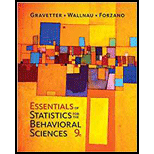
Concept explainers
For the following set of scores, find the value of each expression:
| X |
| 1 |
| 2 |
| 4 |
| 1 |
| 3 |
a. ΣX2
b. (ΣX)2
c. Σ(X + 1)
d. Σ(X + 1)2
a.
To Find: The value of
Answer to Problem 19P
Explanation of Solution
Given info:
X represents the scores. The scores are 1, 2, 4, 1, and 3.
Calculation:
X represents the scores.
Y represents the values when square of each score is done, that is:
Then,
Software procedure:
Step-by-step procedure to obtain the
- Go to Variable View> Enter the name of the variable as X and second variable as Y.
- Go to Data View>Enter the values of X.
- Go to Transform>Choose Compute variable>Enter Y in Target Variable> choose X >Move X to Numeric Expression.
- Choose (^) sign > Enter 2.
- Choose OK.
- Choose Analyze > Descriptive Statistics> choose Descriptive.
- Select Y and move it under variable(s)>Choose Options>Select Sum.
- Choose Continue> choose OK.
Output using the SPSS software is given below:
| Descriptive Statistics | ||
| N | Sum | |
| Y | 5 | 31.00 |
| Valid N (listwise) | 5 | |
From the SPSS output, the value of
Conclusion:
The value of
b.
To Find: The value of
Answer to Problem 19P
Explanation of Solution
Given info:
X represents the scores.
The scores are 1, 2, 4, 1 and 3.
Calculation:
X represents the scores.
Software procedure:
Step-by-step procedure to obtain the
- Go to Variable View> Enter the name of the variable as X.
- Go to Data View>Enter the values of X.
- Choose Analyze > Descriptive Statistics> choose Descriptive.
- Select X and move it under variable(s)>Choose Options>Select Sum.
- Choose Continue.
- choose OK.
Output using the SPSS software is given below:
| Descriptive Statistics | ||
| N | Sum | |
| X | 5 | 11.00 |
| Valid N ( list wise ) | 5 | |
From the SPSS output, the value of
The value of
Conclusion:
The value of
c.
To Find: The value of
Answer to Problem 19P
Explanation of Solution
Given info:
X represents the scores.
The scores are 1, 2, 4, 1 and 3.
Calculation:
X represents the scores.
Y represents the values when 1 is added from each score, that is:
Then,
Software procedure:
Step-by-step procedure to obtain the
- Go to Variable View> Enter the name of the variable as X and second variable as Y.
- Go to Data View>Enter the values of X.
- Go to Transform>Choose Compute variable>Enter Y in Target Variable
- Choose X >Move X to Numeric Expression.
- Choose (+) sign > Enter 1.
- Choose OK.
- Choose Analyze > Descriptive Statistics> choose Descriptive.
- Select Y and move it under variable(s)>Choose Options>Select Sum.
- Choose Continue
- choose OK.
Output using the SPSS software is given below:
| Descriptive Statistics | ||
| N | Sum | |
| Y | 5 | 16.00 |
| Valid N (listwise) | 5 | |
From the SPSS output, the value of
Conclusion:
The value of
d.
To Find: The value of
Answer to Problem 19P
Explanation of Solution
Given info:
X represents the scores.
The scores are 1, 2, 4, 1 and 3.
Calculation:
X represents the scores.
Y represents the values when 1 is added from each score and then squaring it that is:
Then,
Software procedure:
Step-by-step procedure to obtain the
- Go to Variable View> Enter the name of the variable as X and second variable as Y.
- Go to Data View>Enter the values of X.
- Go to Transform>Choose Compute variable>Enter Y in Target Variable.
- Write (X+1)*(X+1) in Numeric Expression.
- Choose OK.
- Choose Analyze > Descriptive Statistics> choose Descriptive.
- Select Y and move it under variable(s)>Choose Options>Select Sum.
- Choose Continue> choose OK.
Output using the SPSS software is given below:
| Descriptive Statistics | ||
| N | Sum | |
| Y | 5 | 58.00 |
| Valid N (listwise) | 5 | |
From the SPSS output, the value of
Conclusion:
The value of
Want to see more full solutions like this?
Chapter 1 Solutions
Essentials of Statistics for The Behavioral Sciences (MindTap Course List)
 College Algebra (MindTap Course List)AlgebraISBN:9781305652231Author:R. David Gustafson, Jeff HughesPublisher:Cengage Learning
College Algebra (MindTap Course List)AlgebraISBN:9781305652231Author:R. David Gustafson, Jeff HughesPublisher:Cengage Learning Mathematics For Machine TechnologyAdvanced MathISBN:9781337798310Author:Peterson, John.Publisher:Cengage Learning,
Mathematics For Machine TechnologyAdvanced MathISBN:9781337798310Author:Peterson, John.Publisher:Cengage Learning,
 Holt Mcdougal Larson Pre-algebra: Student Edition...AlgebraISBN:9780547587776Author:HOLT MCDOUGALPublisher:HOLT MCDOUGAL
Holt Mcdougal Larson Pre-algebra: Student Edition...AlgebraISBN:9780547587776Author:HOLT MCDOUGALPublisher:HOLT MCDOUGAL Algebra: Structure And Method, Book 1AlgebraISBN:9780395977224Author:Richard G. Brown, Mary P. Dolciani, Robert H. Sorgenfrey, William L. ColePublisher:McDougal Littell
Algebra: Structure And Method, Book 1AlgebraISBN:9780395977224Author:Richard G. Brown, Mary P. Dolciani, Robert H. Sorgenfrey, William L. ColePublisher:McDougal Littell Elementary AlgebraAlgebraISBN:9780998625713Author:Lynn Marecek, MaryAnne Anthony-SmithPublisher:OpenStax - Rice University
Elementary AlgebraAlgebraISBN:9780998625713Author:Lynn Marecek, MaryAnne Anthony-SmithPublisher:OpenStax - Rice University





